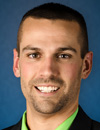CFE Heard the Call to Fight Fraud as a Teenager
/MEMBER PROFILE
Samuel Martin, CFE, CPA
Partner, Brotemarkle, Davis & Co LLP
Raised in the small town of Robbins, California, Samuel Martin, CFE, CPA, was in his teens when he witnessed a family friend lose his business, home and livelihood to embezzlement. The incident sparked Martin’s passion for fighting fraud within vulnerable small businesses. “I began reading and hearing more about how much of an issue this was with businesses today,” Martin said. “That [fraud] didn’t only affect the large corporations. The small business owners were being affected, too, and the impact was much larger on them.”
You call yourself “Inspector Gadget” on your LinkedIn profile. Why do you think that title suits what you do in your role?
I think that title fits me because I spend nearly all of my time performing compliance audits for different companies and looking for ways to help small business owners improve their controls and become successful. I always look to technology to help improve this process and help business owners strengthen their controls, especially when they lack adequate segregation of duties.
What do you wish you knew (but didn’t) when you first contemplated this career?
This career has evolved beyond someone sitting behind a desk all day crunching numbers. You need to be able to go out and talk to a lot of different people on a regular basis and sometimes give them information that they aren’t happy to receive. This could be a tough task for an introvert like me, but it’s enjoyable to know that by developing relationships, business owners respect your thoughts and are willing to embrace your recommendations.
Did you always plan to pursue the position that you are currently in?
I always had a desire to help people. This seemed to be a natural fit, to be a person behind the scenes helping business owners with issues they might have, but who lack someone within their organization to solve these kinds of problems.
Are there any trends (e.g. demographic, social, legal) that concern you?
I have concerns around the increased desire for companies to streamline their processes as much as possible and the increased reliance on services like online banking. Without the proper oversight and segregation of controls, I think this is going to be a huge arena for misappropriation of assets. Bookkeepers already have the ability to pay utilities, car payments and credit cards via EFT, so if the owner or someone else is not watching what’s happening they could leave themselves exposed to serious issues.
What advice do you have for those looking to become a CFE?
I have a passion to help business owners prevent fraud from occurring within their organization, so for individuals looking to become a CFE there are a lot of different opportunities out there where the education and knowledge of the CFE can be useful in their careers. Gaining an understanding of how people commit fraud and what type of frauds are currently being committed helps with the continued analysis and development of internal controls. Recently I discovered how easy it is for an employee to alter payroll after being approved by adding reimbursable expenses to their paycheck and getting paid for expenses never incurred. This bypassed any approval process and the need to have a check signed.
When you are not working, what types of things do you enjoy doing?
When I am not in the office I enjoy do it yourself projects, especially wood working and home improvements. I like these types of projects; they allow me to take a pile of raw materials and transform them into a finished project. I can take an old piece of furniture that is ready to be tossed into the trash and spend some time restoring it back to something that can be enjoyed for years to come.
Read Martin's full profile on ACFE.com.



